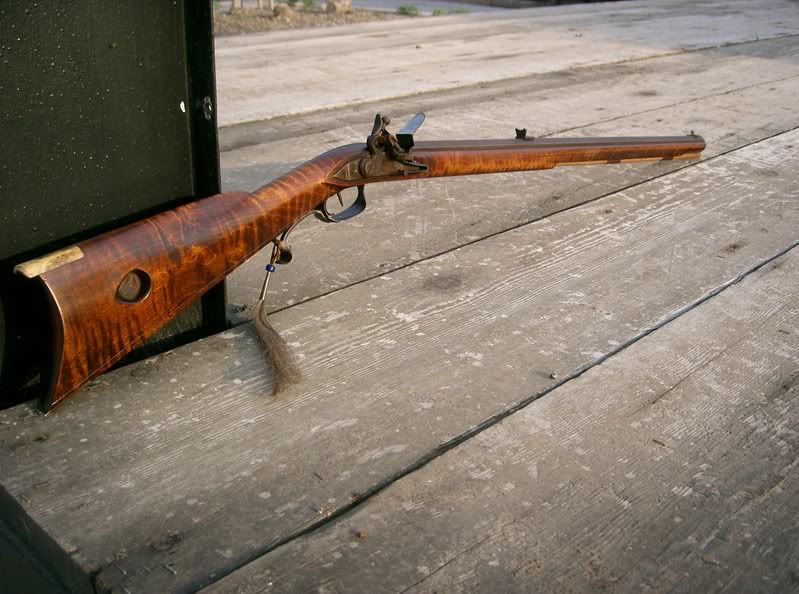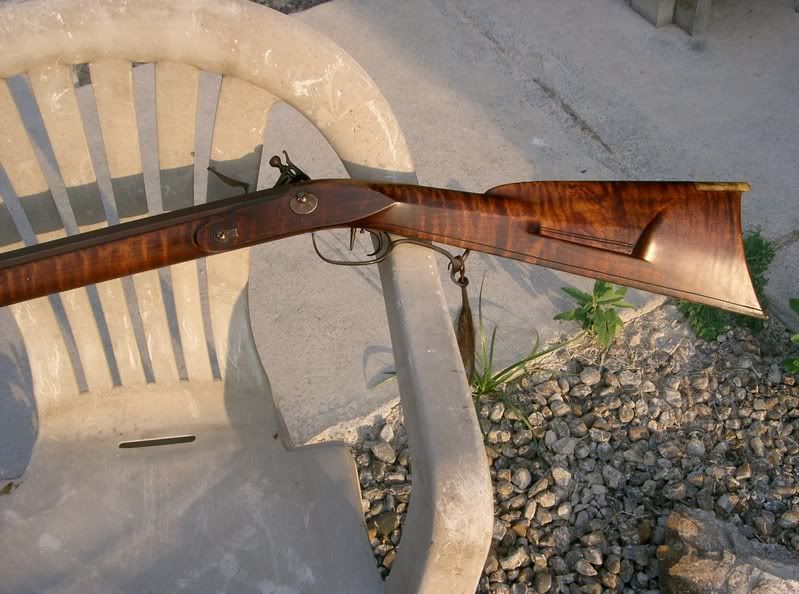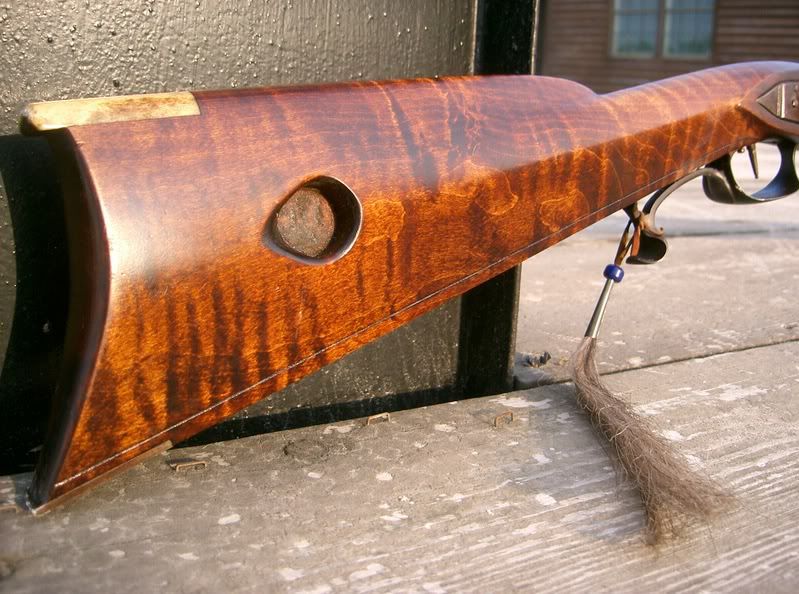-
Friends, our 2nd Amendment rights are always under attack and the NRA has been a constant for decades in helping fight that fight.
We have partnered with the NRA to offer you a discount on membership and Muzzleloading Forum gets a small percentage too of each membership, so you are supporting both the NRA and us.
Use this link to sign up please; https://membership.nra.org/recruiters/join/XR045103
You are using an out of date browser. It may not display this or other websites correctly.
You should upgrade or use an alternative browser.
You should upgrade or use an alternative browser.
toe plates
- Thread starter srottman
- Start date

Help Support Muzzleloading Forum:
This site may earn a commission from merchant affiliate
links, including eBay, Amazon, and others.
srottman,
The only way I know of to get one, is to make one.
Find an appropriately sized piece of bone/antler, slab saw it on bandsaw and flatten/shape to size. It's then simple to inlett and file to fit the profile of the stock, just like you would one made of brass or steel.
Hope that helps.
The only way I know of to get one, is to make one.
Find an appropriately sized piece of bone/antler, slab saw it on bandsaw and flatten/shape to size. It's then simple to inlett and file to fit the profile of the stock, just like you would one made of brass or steel.
Hope that helps.
Guest
srottman,
If you are asking about original pieces, I cannot recall ever having seen such a toe plate or comb plate on an original southern mountain rifle or on any other school, at least on originals predating say 1950. Its a neat idea, but I think its part of the modern 20th century 'poorboy' culture. I'm not saying you shouldn't do it, just that it wasn't a common thing in the 18th or 19th century. The buttplate-less southern guns I've seen were just plain ol' wood. An occasional Appalachian rifle appeared to have some sheet brass or leather tacked on, but even those appeared to have some wear at the heel before that was added.
Sean
If you are asking about original pieces, I cannot recall ever having seen such a toe plate or comb plate on an original southern mountain rifle or on any other school, at least on originals predating say 1950. Its a neat idea, but I think its part of the modern 20th century 'poorboy' culture. I'm not saying you shouldn't do it, just that it wasn't a common thing in the 18th or 19th century. The buttplate-less southern guns I've seen were just plain ol' wood. An occasional Appalachian rifle appeared to have some sheet brass or leather tacked on, but even those appeared to have some wear at the heel before that was added.
Sean
Black Hand
Cannon
- Joined
- Mar 17, 2005
- Messages
- 9,348
- Reaction score
- 895
A toe plate of antler or bone seems to defeat the original purpose of a toe plate. It would chip as easily, if not more easily than the original wood. Pretty but not very functional.....
paulvallandigham
Passed On
- Joined
- Jan 9, 2006
- Messages
- 17,538
- Reaction score
- 87
Are you sure you are looking at Toe plates, or at the Heel plate? I see lots of heel plates made of bone or antler, on both original and replica guns. Toe plates, if they exist, are usually made from sheet brass, or sheet steel. Not all originals had toe plates, particularly if they had no buttplate, either.
Because of the way guns are often stood upright against walls, or corners, it makes more sense to put something stronger than wood at the heel, as with the stock pitch, the toe of the stock is often lifted up off the floor when a gun is leaned against a corner, doortrim, or wall. If the heel plate is squared at the back end, it lends stability( just a little) to the gun as the muzzle of the octagon barrel is also leaned against the flat edge of the top flat.
My Poor Boy Tennessee style rifle has NO buttplate, but has both a heel plate, made of antler, and a toeplate of steel.
In the same vein, the first custom Southern Rifle I saw had these features, as well as a muzzlecap made from antler. Very pretty piece. :hmm:
Because of the way guns are often stood upright against walls, or corners, it makes more sense to put something stronger than wood at the heel, as with the stock pitch, the toe of the stock is often lifted up off the floor when a gun is leaned against a corner, doortrim, or wall. If the heel plate is squared at the back end, it lends stability( just a little) to the gun as the muzzle of the octagon barrel is also leaned against the flat edge of the top flat.
My Poor Boy Tennessee style rifle has NO buttplate, but has both a heel plate, made of antler, and a toeplate of steel.
In the same vein, the first custom Southern Rifle I saw had these features, as well as a muzzlecap made from antler. Very pretty piece. :hmm:
I think there is some confusion about what is "the toe of the stock".
All of the books I have indicate that the "toe" of the stock is the place where the rear of the stock (the butt) meets the bottom surface when the gun is held in a normal firing position.
Places which sell hardware and furniture for muzzleloading guns also refer to the pieces of metal which go in this location as "toe plates".
Because the butt of the gun is placed on the ground (or your shoe or a pad) while loading the wood in this area of the stock is easily damaged.
This of course was why many original and reproduction muzzleloaders have the plate. It reinforces the wood at this often sharp corner to prevent marring or breakage.
Because the toe plate is a structural piece as well as being decorative I don't think that a material like a piece of thin horn or bone would be able to but up with the abuse the stocks toe is subject to with normal usage.
That is at least the way I see it.
All of the books I have indicate that the "toe" of the stock is the place where the rear of the stock (the butt) meets the bottom surface when the gun is held in a normal firing position.
Places which sell hardware and furniture for muzzleloading guns also refer to the pieces of metal which go in this location as "toe plates".
Because the butt of the gun is placed on the ground (or your shoe or a pad) while loading the wood in this area of the stock is easily damaged.
This of course was why many original and reproduction muzzleloaders have the plate. It reinforces the wood at this often sharp corner to prevent marring or breakage.
Because the toe plate is a structural piece as well as being decorative I don't think that a material like a piece of thin horn or bone would be able to but up with the abuse the stocks toe is subject to with normal usage.
That is at least the way I see it.
paulvallandigham
Passed On
- Joined
- Jan 9, 2006
- Messages
- 17,538
- Reaction score
- 87
I always thought the stock was compared to the human foot. We talk about " Drop at Heel", and Drop at comb, to determine the shape of the top of the stock, which would be analogus to the human calf, or rear of the leg. The Butt of the stock is analogus to the bottom of the human foot. and the "toe" is at the opposite end of the heel, or at the bottom of the butt when its mounted against your shoulder/chest.
If I have this wrong, BOY, HAVE I BEEN WRONG for a lot of years! :shocked2: And, that doesn't explain why we talk about "Drop at Heel !!!", in measuring stocks. :hmm: :surrender: :thumbsup:
If I have this wrong, BOY, HAVE I BEEN WRONG for a lot of years! :shocked2: And, that doesn't explain why we talk about "Drop at Heel !!!", in measuring stocks. :hmm: :surrender: :thumbsup:
paulvallandigham
Passed On
- Joined
- Jan 9, 2006
- Messages
- 17,538
- Reaction score
- 87
On a modern rifle stock, and on some MLers, its the raised cheek piece. :grin:
rabbit03
50 Cal.
- Joined
- Apr 1, 2005
- Messages
- 1,143
- Reaction score
- 17
Maybe you meant something like this!
Rifle made by Chuck Oder of the Friendship, Indiana Gunsmith fame!
I bought it from Eddy May and ended up selling it back to its maker Chuck Oder when I realized it was too small for me.
Mr. Oder made the rifle in the early to mid 70's as I recalled him telling me.



rabbit03
Rifle made by Chuck Oder of the Friendship, Indiana Gunsmith fame!
I bought it from Eddy May and ended up selling it back to its maker Chuck Oder when I realized it was too small for me.
Mr. Oder made the rifle in the early to mid 70's as I recalled him telling me.



rabbit03
srottman: Thanks for the compliment. :grin:
The amount of curl in a #2 grade stock depends on who you buy it from.
Most folks agree that Pecatonica River grades their stocks low so what some places call #3 PR calls #2. What PR calls #3 other places call #4 I've used both of PR's #2 and #3 grades.
Usually PR's #2 has some nice curl in it but PR's #3 is excellent with stripes very evident on both sides and for the full length.
Paul. When I think of "Drop at the heel" I think of the measurement from the center of the barrel down to the top of the stock right at the top of the butt plate. I also think "Drop at Comb" is the measurement from the center of the barrel to the foremost high place on the comb.
The amount of curl in a #2 grade stock depends on who you buy it from.
Most folks agree that Pecatonica River grades their stocks low so what some places call #3 PR calls #2. What PR calls #3 other places call #4 I've used both of PR's #2 and #3 grades.
Usually PR's #2 has some nice curl in it but PR's #3 is excellent with stripes very evident on both sides and for the full length.
Paul. When I think of "Drop at the heel" I think of the measurement from the center of the barrel down to the top of the stock right at the top of the butt plate. I also think "Drop at Comb" is the measurement from the center of the barrel to the foremost high place on the comb.
Similar threads
- Replies
- 27
- Views
- 2K
- Replies
- 7
- Views
- 868



